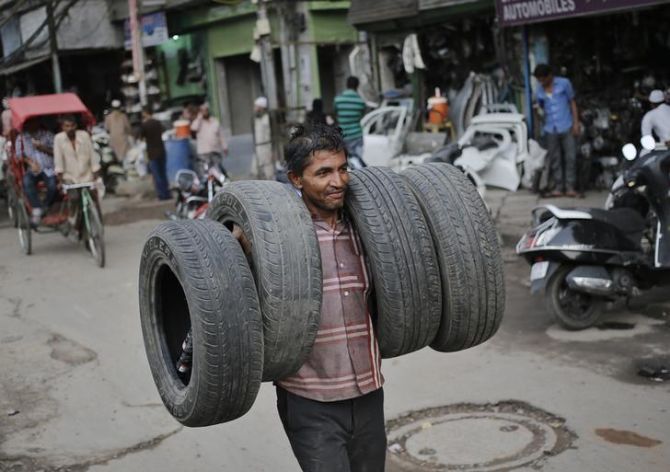The margins of tyre manufacturers could come under pressure given the rise in rubber prices and the moderating demand for tyres.

In the past three quarters, the revenue growth for listed tyre companies has moderated from low to mid-single-digit on account of factors such as lower demand in replacement segments, weak export markets and the decline in the average selling prices to car makers (OEMs).
Demand trends could remain muted in the near term, given the weak passenger vehicle replacement demand, assuming a typical replacement cycle of 3-5 years, and demand moderation in the OEM segment.
Further, the sluggish demand trends in the commercial segment could also impact truck/ bus radials (TBR) and TBB (truck/ bus bias) replacement sales.
This could be partly offset by export recovery.
Among companies in the sector, Apollo Tyres has underperformed Ceat and MRF, due to the market share loss in the PCR (passenger car radial) replacement segment as it is focused on profitability.
Meanwhile, international and domestic natural rubber pr ices (spot) have risen by 22-32 per cent from the Q2FY24 average levels, driven by supply concerns. Leading natural rubber producers such as Thailand, Mal aysia and Indonesia are witnessing lower output, due to adv erse weather.
In the first two months of CY24, the global natural rubber supply stood at 2.25 million tonnes versus the global consumption of 2.44 million tonnes.
The rubber prices may sustain at current levels or rise, given the widening global supply deficit and steady demand.
Further, crude prices have risen a little, which will also hit profitability.
The uptick in overseas freight costs due to the Red Sea crisis is another headwind.
This month, domestic tyre companies have cut prices in the TBR segment by about 1.5-2 per cent, which implies low demand in the CV replacement segment.
Tyre companies may be able to pass on the commodity price increase in the PCR and 2W replacement segments but it is more challenging to pass on price hikes in the CV segment.
Moreover, there is every cha nce based on historical trends that domestic rubber prices will rise further, which could impact gross margins by up to 450 basis points.
For tyre companies, a 100 basis points impact on margins, translates into a 5-7 per cent operating profit impact and 9-12 per cent impact on net profit.
Apollo has the highest exposure to the truck and bus segment (about 60 per cent share) and the TBR segment accounts for around 35 per cent of its standalone revenue.
It is likely to see operating profit margin compression from around 18 per cent which is well above its historical mean margin of 12-13 per cent.
Hence, the annual revenue growth is likely to be in the range of 5-6 per cent and the operating profit margin could fall by around 200 basis points.
If we look at profitability in terms of operating profit/kg, all the listed rubber companies may be overvalued.
The operating profit/kg in Q2FY24 was around 50 per cent higher on average than the mean for the last decade and it is likely to normalise.
This could lead to a de-rating of listed stocks across the tyre sector.
Disclaimer: This article is meant for information purposes only. This article and information do not constitute a distribution, an endorsement, an investment advice, an offer to buy or sell or the solicitation of an offer to buy or sell any securities/schemes or any other financial products/investment products mentioned in this article to influence the opinion or behaviour of the investors/recipients.
Any use of the information/any investment and investment related decisions of the investors/recipients are at their sole discretion and risk. Any advice herein is made on a general basis and does not take into account the specific investment objectives of the specific person or group of persons. Opinions expressed herein are subject to change without notice.












 © 2025
© 2025